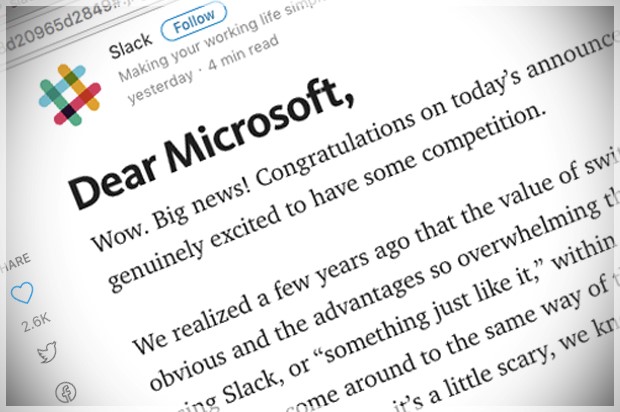It would be a huge understatement to say that it’s been a whirlwind few months for Slack.
It has been widely publicised – mainly on Twitter – that Slack has suffered multiple outages. Some only lasting 20 minutes but others considerably longer. Whilst Slack have dealt with the saga perfectly, it’s happening a little too often for users to feel completely comfortable.
In more positive news, Slack officially made the Microsoft competitor list. Whilst this sounds a little melodramatic, this list is a who’s who of successful business that could genuinely lure customers away from at least one part of the Microsoft stack. This could be, in part, why we saw the launch of Microsoft Teams Free earlier this year.
And now they’ve got loads more money. Slack has just raised $841m with the latest funding round led by Dragoneer Investment Group and General Atlantic. That takes the company’s net worth to $7.1bn. You can see why Amazon seemingly wanted to make a purchase last year, even at $9bn.
That Open Letter
If you cast your mind back to November 2016, Slack bought an entire page in the New York Times to congratulate Microsoft on their announcement of Microsoft Teams. This also came with a warning that it takes years of blood, sweat and tears to get it right.

Microsoft followed up by taking a huge share of the collaboration market. According to Nemertes Team Collaboration Study this year, Microsoft has a whopping 32% share of the collaboration market. When you factor in the players other than Slack, giants like Cisco and Google, Microsoft have done a pretty good job in getting in right.
Microsoft’s success is important for Slack. Being named as an official competitor means Slack now need to keep up, to remain a competitor. This prompts the obvious question.
What will Slack do next?
We’ve already seen lots of little feature tweaks like away messages and time sensitive statuses. But, there must be something big coming. With Google and Microsoft showing off their latest AI work and virtual Personal Assistants, Slack are sure to have something in the pipeline, but the curtains remain closed.
What Slack are going to do with the new funding is currently unknown.
What has everybody else done?
Microsoft has all but made Teams the replacement for Skype for Business. Yes, Skype for Business will have its place for a long time yet, but the flagship collaboration product, Teams, now comes with pre-packaged enterprise voice. Making it enterprise ready Unified Comms & Collaboration (UC&C).
Back in February 2018, UC Today asked a question about Slack, Does it Really Have a Place in Enterprise UC&C? The conclusion was that Slack were knocking on the door of enterprise UC&C and causing the biggest vendors a headache.
Since then, Microsoft have evolved Teams to their flagship product and taken the onus away from Skype for Business as their go-to communications platform. The collaboration platform became the everything platform.
Cisco did similar. Following the acquisition of BroadSoft, Cisco Spark had a facelift and became Cisco Webex Teams. The combination of BroadSoft’s enterprise voice capabilities was intertwined with the flagship collaboration platform.
Google, on the face of it, the fourth big name in collaboration right now, have taken a different approach. With no obvious interest in the enterprise voice market, Google Hangouts have recently announced live stream capabilities. A perfect example of taking a market leading B2C platform (YouTube) and finding a business use for it.
What are Slack’s options?
There are three options for Slack to remain competitive in this landscape.
- Conferencing; big boy conferencing. Cisco and Microsoft all have mature video conferencing suites with associated hardware and integrations. The full virtual meeting experience with everything we’ve come to expect. Then they just need to crack broadcast meetings and live streaming to keep up with Google Hangouts. It needs to be done well, it needs to work first time and it needs to become another reason users never navigate out of Slack
- Enterprise voice. There are fewer things more frustrating than not being able to make a phone call from your favourite collaboration app. Sure, you can make internal calls in Slack – and that’s enough for some businesses. But, for enterprises, it absolutely isn’t. To compete fully with the likes of Microsoft and Cisco, Slack needs a phone system. It needs to be done well, it needs to work first time and it needs to become another reason users never navigate out of Slack
- Something else. This will likely be what we see from Slack. $841m is a lot of money. You could throw around all sorts of marketing buzzwords when speculating what Slack could do – Artificial Intelligence, Interoperability, Virtual Reality to name a few. Whilst it doesn’t seem necessary – but don’t count it out- we probably won’t be donning our Slack wearables any time soon. Whatever it is, it needs to be done well, it needs to work first time and it needs to become another reason users never navigate out of Slack
The unknown
It is not clear what Slack intend to do – if anything –to keep up with the likes of Microsoft. It would be embarrassing to publish an open letter in the New York Times stating how hard something is, only to be shown it is possible in a quick timeframe, and not bounce back with something major.
As a technology writer, user and fan, it’s intriguing to see what happens next. Also, as a technology writer, it’s important to end an article with something meaningful. But Slack hasn’t let us know what that is yet. Watch this space.






